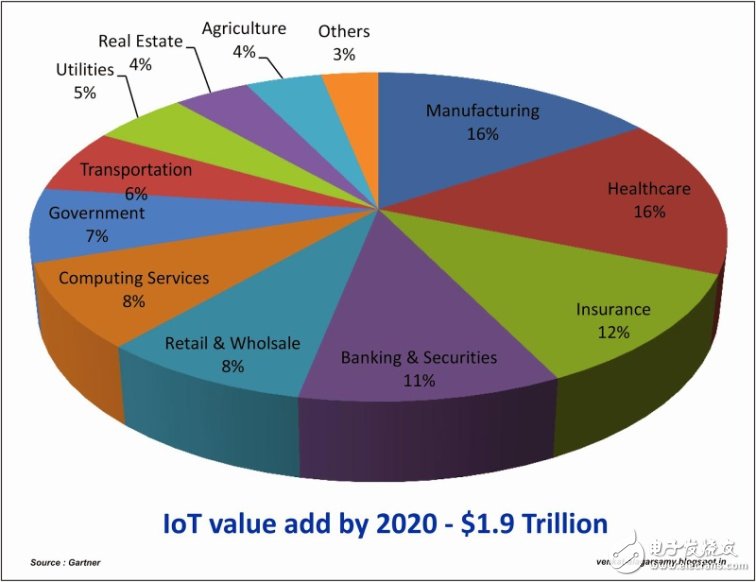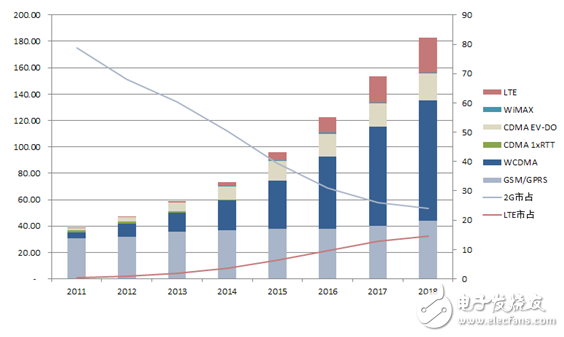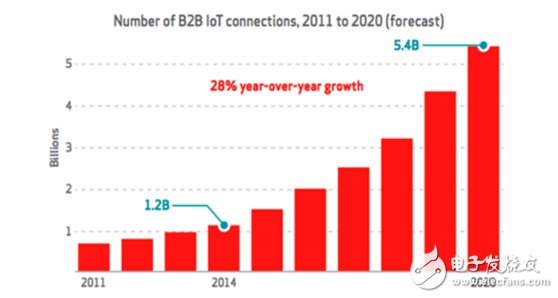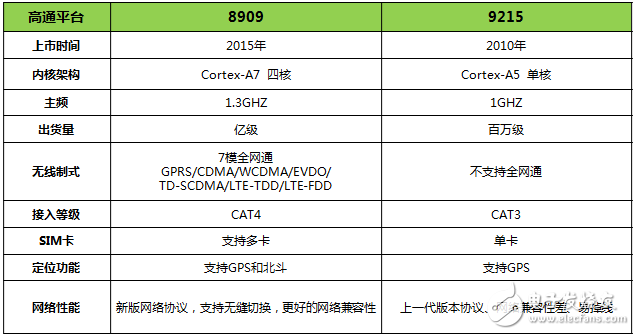The Internet of Everything has taken shape, and the performance indicators and upgrades of IOT wireless communication modules have become the cornerstone and vane of the depth and strength of IoT applications. In October 2015, technology industry analyst firm Linley Group predicted that by 2020, the number of IoT devices worldwide will exceed 1.9 billion. Among them, Linley Group's founder, Linley Gwennap, made it clear that IoT devices cover many fields. It is expected that by 2023, the number of IoT devices in the world will exceed the number of smartphones.

In terms of market capacity, there will be more than 1.9 million IoT devices in the world by 2020 (data from Linley Group)
The huge potential of the Internet of Things is undoubted, so what are the functional and performance trends of the M2M module as the cornerstone and core? How will we push the application of the Internet of Things industry to a deeper, broader and higher level from a deeper level?
First, 2G/3G is unstoppable to 4G evolution, and IoT applications are welcoming 4G spring
Entering 2015, the 4G network is developing rapidly (accelerating at 134%). The proportion of 2G network traffic and utilization is declining. Global operators are gradually closing 2G networks. From the perspective of improving spectrum utilization and reducing management costs, Promote the evolution of M2M module system to 4G, and LTE has become the main focus of the development of IoT communication module products and market competition.

From the perspective of the system, the development trend of M2M modules from 2011 to 2018 (data from ABI research)
In the domestic market, taking mobile phones as an example, according to the “August 2015 Domestic Mobile Phone Market Operation Analysis Report†released by the Ministry of Industry and Telecommunications Research Institute, the data of 2G mobile phone shipments was 37.812 million in January-August 2015, a year-on-year increase of 0.7%. 3,660 million 3G mobile phones, down 91.1% year-on-year; 4,400 million 4G mobile phones, an increase of 306.9%. 2G is gradually declining, and 3G is facing elimination. China's three major operators have actively deployed after the issuance of 4G licenses. China Mobile expects to build 1 million TD-LTE base stations by the end of the year. The population coverage of the whole network can reach 85.4%. China Telecom is expected to build 470,000 this year. The FDD-LTE base station conforms to the general trend of switching from 2G/3G to 4G in the global market.
Similarly, the LTE cat4 4G M2M module from several industry-leading smart-connected companies such as Telit, Shenzhen, and Neoway has also confirmed the market trend of the development of the Internet of Things.
Resisting or embarrassing, 4G is already around. At present, there are still many places in the growing 4G that need to be improved and improved in terms of stability, coverage, and compatibility. Therefore, in the transformation of smart connected 4G, what kind of challenges will the IoT industry face in full swing, what application worries exist, and how to deal with the urgent issues that have become the thinking of the vast IoT industry.
Second, the national entrepreneurship, all things Zhilian, 4G M2M module to promote industry applications to a deeper, broader, higher
According to ABI research data, in the next three years, the reach of IoT applications will be fully extended. Vehicles, smart grids, mobile payments, green agriculture, remote monitoring and industrial control will become larger shipments of long-distance M2M modules. The five areas will grow rapidly with a growth rate of up to 28% per year. There is no doubt that the emergence of 4G modules is the core driving force for the rapid development of long-distance Internet of Things applications.

From the market growth rate, the growth trend of M2M module shipments from 2014 to 2020 (data from ABI research)
Similarly, in the era of entrepreneurship and innovation in China, the Internet of Things industry with M2M modules as the core has become the leader. We believe that we are also looking forward to more cross-border integration of IoT products and The business ecology has emerged one after another.
Then, in the opportunity of high-speed and diverse IoT industry development, there are many stage obstacles such as stability, compatibility, coverage, and even cost competitiveness in the 4G transformation. Hesitation and awkwardness will not help, only calm. Analysis and taking advantage of the trend are the only correct choices.
1. The road determines fate. Where does the 4G M2M module become the top priority for the 4G application?
For the M2M IoT application, the laboratory products work normally, and there is still an armpit phenomenon at the scene; the base station switching, 2G/3G/4G network switching still appears to be dropped, which is an unavoidable problem. In the 4G era, what kind of technical road should I choose to adapt to the development of 4G? There are two points of thinking here that deserve attention.
A) 4G camp selection. We know that as the skeleton of mobile communication, the product solution of base station equipment is mainly the world of Qualcomm. It is undeniable that even as a patent holder of 3G/4G core technology, due to lack of sufficient field test in previous years, Qualcomm MODEM products before 2014 still have some shortcomings in network compatibility. As you can imagine, other non-Qualcomm platforms will definitely encounter more challenges. Whether it is with the mainstream or another way is a question worthy of deep thinking.
B) 4G platform selection. Qualcomm, which keeps pace with the times, has not stopped. Currently widely used is the Qualcomm MDM9x15 platform, which has been on the market for 5 years (expected to be delisted), and the annual shipments are only one million, which cannot meet the explosive growth of the M2M market. The launch of the latest Qualcomm 4G 8909 platform is just the right time, with billion-level capacity, becoming the main platform carrier for IoT applications in the new era. At this time, as the IoT module enterprise that pays attention to Zhilian, who can seize the platform, it will become the tide of the Internet of Things market.
2, "Full Netcom" has gradually become a necessity, "One Model and Three Cards" has become the best choice for IoT applications.
The concept of “Full Netcom†is generated in smart phone applications. Individual customers want to purchase any one of the three major operators as a service provider. This choice will not change for a long time. Different from personal consumer products, industry applications need to consider dynamic adaptation, comprehensive performance, and more need to overcome the remote installation location, adverse and unstable environmental factors, it is best to switch operators in real time. At the same time, it supports three SIM cards, supports three major operators, and is fully stereo compatible with each 2G, 3G, 4G standard, and switching between base stations, so that products can be more stable every time in different sites and different industrial mines. A more economical connection, this is the highest level of so-called 4G smart connection.
Obviously, the "full Netcom" technology is very difficult, and it is not a long-term rooted intelligent connection field. Enterprises with deep mobile communication technology are not competent. As the saying goes: How big is the ability and how big the responsibility is. The goal of the latest Qualcomm 4G 8909 platform is to fundamentally solve the application problems caused by many problems such as on-site armpits, network switching, and even SIM card fitting, which have plagued the industry for many years. Netcom era.
3, real gold is not afraid of fire. The proliferation of IoT terminal product categories, quantities and data volumes further tests module vendors
The earlier IoT module was basically serial communication, with low threshold, slow speed, and single function. In the 4G era, this has not adapted to the needs of applications with greater data throughput, more flexible features, and more robust performance. Looking at it from another angle, simple, static communication modules are no longer suitable for today's vastly diverse IoT applications.
From serial to USB, from USB to PCI-e; from 2G to 3, from 3G to 4G; from isolation to GPS, from GPS to Beidou + GPS; from access capabilities to CAT3 to CAT4; from Bluetooth to FM capabilities A measure of the overall strength of an IoT module enterprise.

Qualcomm 4G 8909 and Qualcomm 9215 platform performance and function comparison table
The explosive growth of the Internet of Things, the proliferation of end products in terms of categories, quantity, etc., at the same time, the desire of big data applications for data volume will inevitably further test the stable supply and flexible production capacity of core module suppliers. It can be said that the non-rooted IoT module market has been incompetent for many years and has not been recognized by the market in the main application areas.
It should be pointed out that those M2M module companies that have mastered the resources of the smart phone industry chain must have a unique comprehensive advantage. It makes sense to guess that if those companies can take the lead in adopting the latest Qualcomm 4G 8909 platform, then who can take the lead in breaking the module cost bottleneck of 4G IoT applications, completely remove the last block of the growth of the Internet of Things.
4. In the era of traffic, stability is overwhelming. Qualcomm 4G 8909 platform will become the "window" of takeoff
In the era when traffic is king, sharing win-win has become the main theme of all walks of life. The monthly fee form in traditional IoT applications is obviously outdated. It is reported that the three major operators who have repeatedly been overtaken by corners have begun to try the traffic pool billing method. From a certain perspective, it can also transmit that the Internet of Things application is about to enter the traffic application phase, which will further enhance the application level of the Internet of Things industry and put forward higher application requirements for relevant industry practitioners.

The traffic application aims to highlight the application user experience and to mass data storage and analysis. In essence, it is necessary to ensure the stability of smart interconnection. In the process of 4G moving towards maturity and stability, the Qualcomm 4G 8909 platform will become the “window†for the flow application to take off.
In short, the transformation and upgrading of the Internet of Things 4G is unstoppable. IoT applications are in the process of 3G moving towards 4G, and opportunities and challenges coexist. No matter whether it is a core module supplier or a colorful IoT terminal enterprise, or even three basic operators, and all kinds of cloud service providers that come to the forefront can not stay out of the game.
The hidden worry cannot be the reason for the development of imprisonment. Hesitation and jealousy can only be an excuse for self-restraint. I believe that as long as the situation is judged, calm analysis, strategic decision-making, and the trend will surely push the Internet of Things application to a deeper, broader and higher ideal.
50W Medical Power Supply,Battery Backup For Medical Equipment,Medical Ac Adapter,Isolated Power Supply For Hospital
Shenzhen Longxc Power Supply Co., Ltd , https://www.longxcpower.com
![<?echo $_SERVER['SERVER_NAME'];?>](/template/twentyseventeen/skin/images/header.jpg)